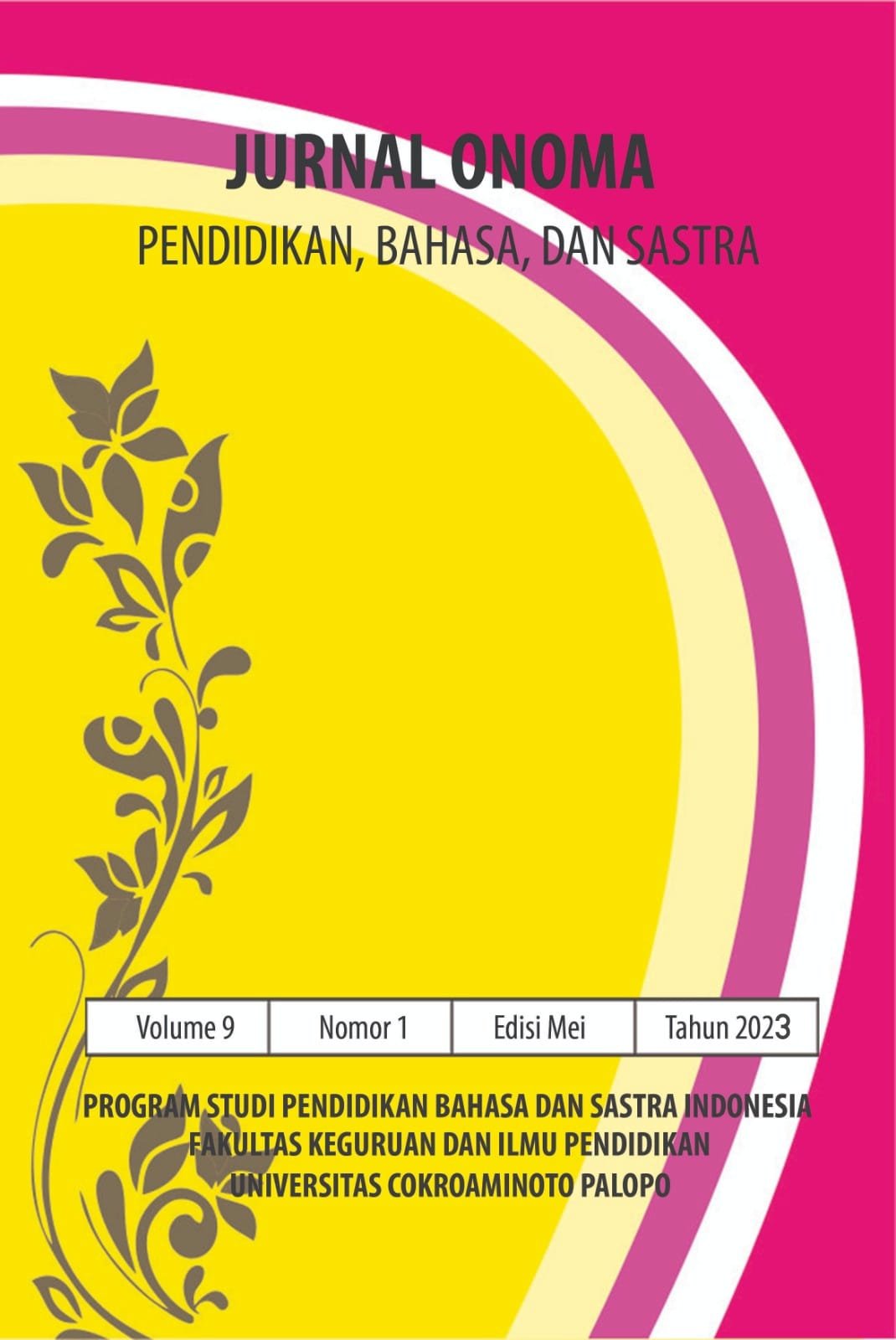Tindak Tutur Ekspresif dalam Film Ranah 3 Warna Karya A. Fuadi
https://doi.org/10.30605/onoma.v9i1.2650
Keywords:
Tindak; Tutur; EkspresifAbstract
Tujuan penelitian ini untuk mendeskripsikan tindak tutur ekspresif dalam film ranah 3 warna. Adapun Metode penelitian menggunakan metode deskriptif kualitatif. Teknik pengumpulan data yang digunakan yaitu teknik dokumentasi. Teknik analisis data berupa tahap deskrpsi, klasifikasi, analisis, interpretasi data, evaluasi, dan kesimpulan. Hasil penelitian ini menunjukkan bahwa tindak tutur ekspresif dalam film ranah 3 warna terdiri atas tindak tutur ekspresif berupa : a) memuji dalam konteks: memuji karena terkesan atau kagum dengan pakaian atau barang yang petutur kenakan; b) mengucapkan terima kasih dengan ciri: mengucapkan terima kasih karena perbuatan baik yang sudah dilakukan petutur, mengucapkan terima kasih atas kenikmatan yang Allah berikan, dan mengucapkan terima kasih karena merasa merepotkan; c) mengucapkan maaf dengan ciri karena telah mengecewakan petutur dan merasa bersalah, d) kebahagiaan dengan ciri: bersyukur atas apa yang dimiliki atau yang telah didapatkan; e) mengeluh dalam konteks: perasaan sedih karena kehilangan diberi cobaan atau halangan dan rintangan. Dengan demikian, tindak tutur ekspresif dalam film rana 3 warna ini terdiri atas tindak tutur ekspresif dalam bentuk memuji, ucapan terima kasih, ucapan permohonan maaf, kebahagiaan, dan tindakan mengeluh.
Downloads
References
Murti, S., Muslihah, N. N., & Sari, I. P. (2018). Tindak Tutur Ekspresif dalam Film Kehormatan di Balik Kerudung Sutradara Tya Subiakto Satrio. Silampari Bisa, 1(1), 17-32. DOI: https://doi.org/10.31540/silamparibisa.v1i1.7
Ariyanti, L. D., & Zulaeha, I. (2017). Tindak tutur ekspresif humanis dalam interaksi pembelajaran di sma negeri 1 batang: Analisis wacana kelas. Seloka: Jurnal Pendidikan Bahasa Dan Sastra Indonesia, 6(2), 111-122.
Ekawati, M. (2017). Kesantunan semu pada tindak tutur ekspresif marah dalam bahasa Indonesia. Adabiyyāt: Jurnal Bahasa dan Sastra, 1(1), 1-22. DOI: https://doi.org/10.14421/ajbs.2017.01101
Irma, C. N., & Sari, I. P. (2020). Analisis tindak tutur ekspresif dalam acara seminar Mario Teguh terbaru 2019. Hasta Wiyata, 3(2), 109-113.
Anggraeni, P. N., & Yudi, A. P. (2021). Analisis Tindak Tutur Ekspresif Dilan dalam Film Dilan 1990. Logat: Jurnal Bahasa Indonesia dan Pembelajaran, 8(1), 27-40. DOI: https://doi.org/10.36706/logat.v8i1.7
Sari, N. W. A. P. (2023). TINDAK TUTUR EKSPRESIF DALAM FILM" KUKIRA KAU RUMAH": STUDI PSIKOPRAGMATIK. Diglosia: Jurnal Pendidikan, Kebahasaan, dan Kesusastraan Indonesia, 7(1).
Rohmadi, M. (2012). Pragmatik Teori dan Analisis. Bandung: Yuma Pustaka.
Ardianto, Tola. (2016). Tindak Tutur Direktif. Litera. Volume 12. Hal. 2.
Suryana. 2010. Metodologi Penelitian. Bandung: Universitas Pendidikan Indonesia.
Vince, Marcello. Beth, Reekles. 2018. The Kissing Booth. New York: Movie
Wardhaugh, R. 1986. Sociolinguistics : An Introduction. New York: Basis Black Well. ss.
Yule, G. (2006). The Study of Language (Third Edition). United States: Cambridge University Press.
Fromkin, Rodman, V. 2009. An Introduction to Language. Cambridge: Cambridge University Press.
Downloads
Published
How to Cite
Issue
Section
License
In submitting the manuscript to the journal, the authors certify that:
- They are authorized by their co-authors to enter into these arrangements.
- The work described has not been formally published before, except in the form of an abstract or as part of a published lecture, review, thesis, or overlay journal.
- That it is not under consideration for publication elsewhere,
- That its publication has been approved by all the author(s) and by the responsible authorities – tacitly or explicitly – of the institutes where the work has been carried out.
- They secure the right to reproduce any material that has already been published or copyrighted elsewhere.
- They agree to the following license and copyright agreement.
License and Copyright Agreement
Authors who publish with Onoma Journal: Education, Languages??, and Literature agree to the following terms:
- Authors retain copyright and grant the journal right of first publication with the work simultaneously licensed under Creative Commons Attribution License (CC BY 4.0) that allows others to share the work with an acknowledgment of the work's authorship and initial publication in this journal.
- Authors are able to enter into separate, additional contractual arrangements for the non-exclusive distribution of the journal's published version of the work (e.g., post it to an institutional repository or publish it in a book), with an acknowledgment of its initial publication in this journal.
- Authors are permitted and encouraged to post their work online (e.g., in institutional repositories or on their website) prior to and during the submission process, as it can lead to productive exchanges, as well as earlier and greater citation of published work.

















